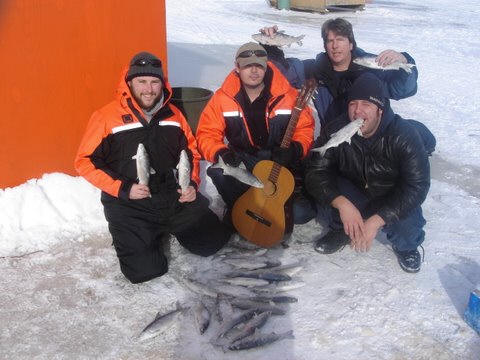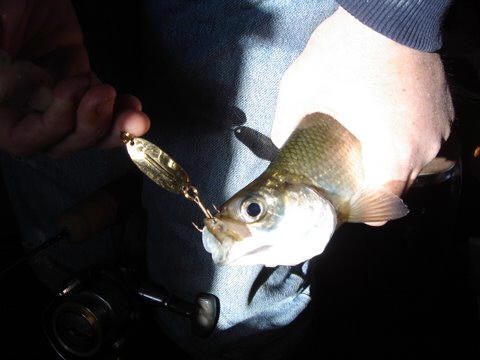You Better
Believe Bait's Fun: Fishing For Ciscoe They move through spots in big schools, and their strikes range from crisp little taps to all-out attacks. Catching one normally means you'll be busy with others for a while. They're good little fighters on panfish-weight fishing tackle, and they're excellent smoked, baked or even fried. They inhabit a huge range of lake types across Ontario, from tea-stained ones with mostly soft bottom to the classic, crystal clear and rocky. Lake herring/ciscoe and great fun.
A quick morning rush of herring for the smoker. They'll come in bunches and everyone with a line down gets in on it. These ones were caught from 9am to 11am, at first ice, on a mix of spoons and plastics Most of the ones you'll be catching are clones, from about ten to thirteen inches long. (Wonder why top selling pike and muskie baits like Jakes and Grandmas come in these two sizes? A lot of what these fish eat to get big is within that exact shape and size bracket.) Ciscoe are one of the most adaptable and varied species we have. They have an extensive range, they're prolific spawners, and there's even evidence suggesting that ciscoe can and will alter their spawning behaviour to offset factors like shoreline development and dropping water levels. Research on big, Minnesota lakes like Mille Lacs has documented spawners dropping eggs over open water, away from their traditional sandy or gravel shoreline spots. There are dozens and dozens of sub-species in the herring family. All I know is whatever they are, they sure are fun to catch! You can catch them on set lines with a couple of baited hooks, but jigging has always been more productive and more fun, at least for me. Meat and flash are the two most important thing in a ciscoe jig. I guess the same can be said about jigs for any other target species. Their mouths are deceptively large when flared open, and the roof is firm and holds the hook solidly. It's almost box-shaped, just like a saltwater tarpon. (Same deeply forked tail, scales and body shape, too.) Like whitefish or crappies, there is some soft membrane around the jaws, and a gentle hand around the hole will help hooks stay put. With upright, single hooks like on small leadheads, you'll get them in the snout or roof of the mouth most of the time. Trebles are often right in there also, often pinning the jaws from both the upper and lower. With a tipped spoon, ciscoe have an amazing ability to suck in the baited hook very accurately. I really like spoons in the one to three inch range for jigging. I normally tip with a minnow head, minnow tail, maggots or a scrap of minnow flesh. The flash from the spoon probably imitates one of their buddies feeding, and the bait seals the deal. Even though most of what these fish eat is suspended plankton and small insect life, they're not shy around larger, baitfish imitating lures. Ciscoe eat a lot of small smelt, perch and other minnows. They'll smack big spoons for lake trout or pike fearlessly sometimes. Of downriggers at other times of the year, I've caught them on lures nearly as big as they are. They're pugnacious. Basic jigging spoon designs like this Williams Wobbler in gold or silver, tipped with some form of livebait or one of the best there is. Other gamefish will take them also. Light line, soft rods and any serviceable little spinning reel is all you need. Four pound monofilament line is optimal, but you can go lighter or heavier, it's up to you. I haven't seen anything to suggest that ciscoes are line-shy, but you do get better action and control out of small baits and lures with light line. Being interrupted by big pike, lake trout or walleyes is also common when you're fishing spots that hold a lot of ciscoes.
Basic jigging spoon designs like this Williams Wobbler in gold or silver, tipped with some form of livebait or one of the best there is. Other gamefish will take them also. Depth and structure is largely lake and season dependant. At the lower end of the food chain, herring are the 'grazing herds' of the lake, following food is their number one priority, and this can take thenm all over the lake in huge schools. They do things in large groups, for safety. Feeding and spawning, especially. In lakes where they have big tracts of deep water and large pods of suspended plankton or smelt, they sometimes drift along deeper structure, near spots you'd commonly associate with lake trout fishing. On shallower, darker lakes, herring will use shallower, flatter and more fertile areas, like sandy or muddy bays with weed growth. Wherever you jig them, always work your way up through the water, from the bottom to the surface. They'll hold and bite at very specific depths, and you can normally rely on that depth range for several fish. The deeper the water, the higher I've found herring will suspend and feed. In water less than twenty feet deep, on lakes like Nipissing, being within five feet of the bottom normally works, as a starting point. Slow, soft bounces with the rod is a good spoon technique. Bounce the rod just high enough and firmly enough to get one or two flutters out of the spoon as it falls. The spoon's overall vertical travel will be less than about eight inches. Then leave it motionless. Most of the time you'll get a firm little tap as the fish sucks in the baited treble. Lift the rod and there you have it. In new holes, more aggressive jigging with the spoon will help call fish over, and they will hit like that, for sure. Long pauses and subtle bumps of the rod are a great triggering move at other times. Williams Wobblers in the W60 size, as well as the smallest size Whitefish are about the best spoons I've used. Year in and year out, they're always catching fish. Small Cleos, Blue Fox Tinglers, Mr.Champs or Angel Eyes also catch fish. A short, stiff mono dropper about four inches long off the end of a spoon works well, too. Use the same small treble and bait it as you normally would. Small plastics are great hookers and really easy to fish. Just as many herring will bite a motionless plastic lure as one that's in motion. Dead-sticking with the odd small light or shake is normally all it takes. Nothing imitates insect larvae or small critters better than a baby tube jig, twister or minnow. There are some awesome mini lures from Berkley that are shaped like mayflies, crayfish and smelts. The fish love them. White, salt and pepper, brown or glow in the dark all work. Little plastics under a float is deadly at times. Lock in the hot depth, and suspend the little bait there. Jiggle the bobber every so often or let wind twitch it around the hole. As long as you stay mobile and work different depths, you will come across herring. Open water can be more intimidating than small, clearly defined structure, but these fish will show themselves quickly once you get on them. Work each hole from top to bottom, and get started on the next one. Peak activity periods in the winter are morning and evening. I've had much less success on numbers or herring at mid day. You will catch them, but the big runs of action are early and late. In the summer and fall, evening is the best time I've found for herring jigging or off downriggers. Some of the biggest and most popular icefishing lakes in Ontario are loaded with ciscoe. If you own perch tackle, it will work on them. They're scrappy fighters, and we should all feel lucky that even at the bottom end of the food chain, we have yet another awesome sporting option in our lakes.
|



